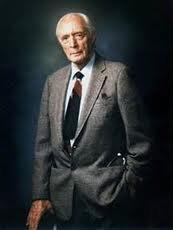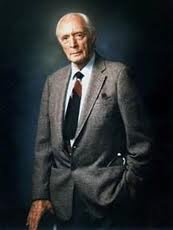Richard J. Bing, who worked with the aviator Charles Lindbergh and the Nobel Laureate Alexis Carrel at the Rockefeller Institute on an early version of the artificial heart and the perfusion of human organs, and whose musical compositions led to a friendship with the composer Carl Orff, died Monday, November 8, 2010. He had celebrated his 101st birthday only three weeks earlier with a performance at his home in La Canada, California of a Haydn Quartet by members of the Los Angeles Philharmonic Orchestra, who had played there on the occasion for many years. He had earlier composed music for the quartet.
Bing left his research laboratory at the age of 98, having published the last of his more than 500 journal articles and medical books in his nineties, but often complained to friends of his "early retirement." His 100th birthday was chronicled in an award-winning documentary "Para Fuera" (loosely meaning "away with all that," after one of his most recent fictional works), which premiered at the Sundance Film Festival.
His discoveries in cardiology, cardiac metabolism, cardiac catheterization, congenital heart disease, blood-flow measurement in the heart, and work (completed in his eighties and nineties) on nitric oxide and its relation to restoring blood flow after a heart attack and the dangers of COX-2 inhibitors, gave him the reputation of a renaissance researcher among his colleagues. He was, however, a renaissance man in other ways as well. He had a lifelong love affair with music—he composed over 300 works that have been performed in the United States, Australia, Austria, and Germany. His musical manuscripts are now housed in the Bing collection at the Doneny Library at the University of Southern California.
In the last decade of his life he also wrote and published five books of fiction.
Richard John Bing was born in Nuremberg, Germany on October 12, 1909. His father was a merchant of hops; his mother was known for her musical talent as a singer of Bach cantatas. At an early age he studied music, and then medicine. Leaving Germany in 1934 during the early period of Nazi rule, he was among the last survivors of a generation educated in Germany and forced to make a life elsewhere. He was educated as a medical doctor in Germany and in Switzerland (he had medical degrees from both countries), and received training in research at the Carlsberg Institute in Copenhagen, where he met Alexis Carrel and Charles Lindbergh, who were visiting the Institute and who subsequently offered him a job at the Rockefeller Institute. From there in 1937 he moved to Columbia University College of Physicians and Surgeons, where he worked under Allen O. Whipple, who developed a procedure for removing a cancerous pancreas, called the Whipple operation; Bing he married Whipple's daughter, Mary. They were married for 52 years, until Mary's death in 1990. After working with the distinguished scientist and philosopher Homer W. Smith at the New York University Physiology Department, Bing moved to Johns Hopkins University. After Pearl Harbor, he enlisted in the U.S. Army where he was eventually promoted to Lieutenant Colonel. Before ending his service, he was asked by the Surgeon General to report on the post-war state of German medicine.
Following the war, Bing returned to Johns Hopkins, then moved to the University of Alabama, Washington University in St. Louis, Wayne State University in Detroit. His last appointments were at the University of Southern California and the Huntington Memorial Research Institutes. He was a key figure in the establishing of the International Society for Heart Research where the Richard J. Bing Award for Young Investigators is given at each World Congress meeting.
At Johns Hopkins School of Medicine from 1941 to 1951, later characterized as Hopkins' golden age of cardiology and cardiac surgery, Bing worked with Alfred Blalock and Helen Taussig, two pioneers in the diagnosis and surgery of congenital heart disease. At Hopkins, Bing organized the first diagnostic cardiac catheterization laboratory. His pioneering catheterization protocols led to the first analyses of the oxygen content of blood in the heart, and the resulting formulae are still used in cardiac laboratories around the world. He was the first to define the physiology of congenital heart disease. Bing's work at Hopkins resulted in the characterization of 20 different forms of cardiac malformations—including the "Taussig-Bing" anomaly, a rare congenital deformation of the heart—and provided a precise diagnosis for surgeons to operate on these infants. It was also at Hopkins where, in the course of a cardiac catheterization, Bing accidentally entered the coronary sinus. This "accident" was the beginning of a new era in cardiac physiology, the study of cardiac metabolism. His honorary degree citation from Johns Hopkins (conferred in 2000, one of three honorary degrees he received during his lifetime) called him "one of the great cardiologists of our time."
After running the Catheterization Laboratory at the School of Medicine at the University of Alabama and becoming professor of medicine at Washington University in St. Louis, he accepted a post as chairman of the Department of Medicine at Wayne State University in Detroit, becoming the first foreign-born head of an American Department of Medicine.
There, in 1964, with his wife's cousin, George Clark, Professor of Physics at Massachusetts Institute of Technology, he developed the use of positron emitters to determine coronary blood flow in man, aided by computers from nearby Ford Motor Company. This laid the foundation for modern PET scanning.
In 1969, Bing accepted an invitation to move his laboratory to Pasadena, California, at the Huntington Medical Research Institutes (HMRI), with additional appointments to the faculty of the University of Southern California School of Medicine and as Director of Medical Education at Huntington Memorial Hospital. At HMRI he continued his work in cardiac physiology and, in cooperation with colleagues at the California Institute of Technology (Caltech), devised methods of visualizing coronary and cerebral microcirculation. Bing was named as a research associate in engineering science at Caltech in 1970, was a visiting associate in biomedical engineering from 1972-1978, a visiting associate in chemistry and chemical engineering from 1978-83, and had been a visiting associate in chemistry since 1984.
Bing was an internationalist. The scientists on his many research teams came from all over the world, from Japan to Europe to Russia. He will be missed on many continents for the encouragement he gave to his junior scientists and for his focus and iron dedication to scientific discovery—and to music.
Bing is survived by three children—John W. Bing of Ewing, New Jersey; Judy Tasker of Thousand Oaks, California; and William W. Bing of Altadena, California—and by numerous grandchildren and great-grandchildren. His daughter Barbara died in 1999 and his sister Elizabeth Sondheimer died, also at 101 years, in 2009.
 Richard J. Bing, 1909-2010.
Richard J. Bing, 1909-2010.

